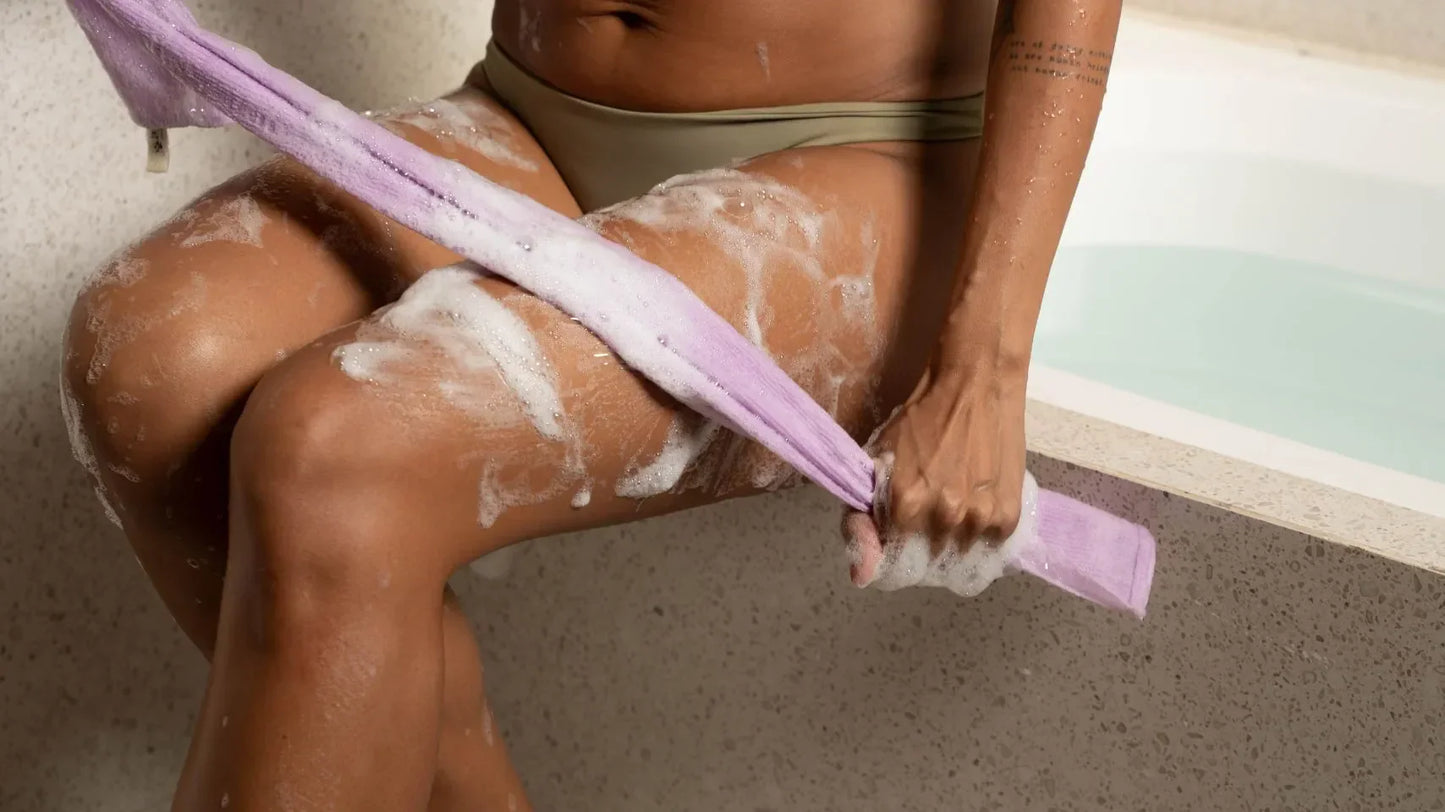Let's face it: we all want that glow. You know, the one that makes people ask, "What's your secret?"
Exfoliation might be the answer. But here's the thing – not all exfoliation is created equal. So, let's dive into skin-sloughing and discover which type might be your ticket to radiant skin.
Understanding Exfoliation
First things first: what exactly is exfoliation? Skin exfoliation is the process of removing dead skin cells from the surface of your skin. It's like freshening your face, revealing the newer, brighter skin underneath. Regular exfoliation can improve skin texture, unclog pores, and even help your other skincare products work better.
But why is skin exfoliation so important? Our skin naturally sheds dead cells every 28 to 40 days. However, this process slows down as we age, leading to a buildup of dead skin cells. This can result in dull, rough skin, clogged pores, and a lackluster complexion. Exfoliation gives nature a helping hand, speeding up cell turnover and revealing that fresh, glowy skin we're all after.
Let's break down the different types of exfoliation and see which one might be your skin's new best friend.

Physical Exfoliation
Think of physical exfoliation as the manual labor of skincare. It involves using something grainy or textured to physically scrub dead skin cells. It's satisfying and immediate, and you can feel it working.
Types of physical exfoliants:
- Scrubs (sugar, salt, coffee grounds)
- Brushes and sponges
- Microdermabrasion tools
Pros:
- Immediate results: You can feel and see the difference right away.
- Improves circulation: The massaging action can boost blood flow to your skin.
- Customizable: You control the pressure and intensity.
Cons:
- It can be too harsh for sensitive skin: It's easy to overdo it and cause irritation.
- Risk of micro-tears: Rough particles can cause tiny tears in the skin if used too aggressively.
- Not ideal for inflamed skin: Physical exfoliation might exacerbate active acne or rosacea.
Best for: Oily or thick skin types that can handle more friction. If you love that "scrubbed clean" feeling, physical exfoliation might be your jam.
How to use: Wet your skin, apply the scrub, or use the tool with gentle, circular motions. Don't press hard – let the product do the work. Rinse thoroughly and follow up with moisturizer.
Chemical Exfoliation
Don't let the word "chemical" scare you off. These exfoliants use acids or enzymes to dissolve the bonds between skin cells, allowing them to shed more quickly. It's like a secret agent working behind the scenes to reveal your best skin.
Types of chemical exfoliants:
- Alpha hydroxyl acids (AHAs), such as glycolic and lactic acids, are great for surface-level exfoliation and improving skin texture.
- Beta Hydroxy Acids (BHAs), like salicylic acid, are Oil-soluble, so they can penetrate deeper into pores, making them ideal for acne-prone skin.
- Poly Hydroxy Acids (PHAs): The gentlest of the bunch, suitable for sensitive skin.
Pros:
- They can penetrate deeper into the skin, so they can more effectively tackle issues like fine lines and uneven skin tone.
- Often gentler than physical exfoliation: Less risk of over-exfoliating or causing micro-tears.
- Multitasking: Many chemical exfoliants offer additional benefits like hydration or acne-fighting properties.
Cons:
- May cause initial purging: As they speed up cell turnover, you might experience temporary breakouts.
- Can increase sun sensitivity: Always follow up with SPF (but you're doing that anyway, right?).
- Requires patience: Results are usually more gradual compared to physical exfoliation.
Best for: Most skin types, especially those with acne, fine lines, or uneven skin tone. If you prefer a "set it and forget it" approach to skincare, chemical exfoliation might be your match.
How to use: Start with a low concentration and use it 1-2 times weekly. Apply to clean, dry skin, wait for the specified time (usually 5-20 minutes), then rinse off or follow with the rest of your skincare routine, depending on the product.

Enzymatic Exfoliation
Think of this as the gentle cousin in the exfoliation family. Enzymatic exfoliants use fruit enzymes to break down dead skin cells. It's like having tiny Pac-Men on your face, gobbling up all the dead skin while leaving the healthy skin alone.
Common enzymes:
- Papain (from papaya)
- Bromelain (from pineapple)
- Actinidin (from kiwi)
Pros:
- Super gentle: Perfect for those with sensitive or reactive skin.
- Natural: If you're into clean beauty, enzyme exfoliants are often derived from fruit.
- Self-limiting: Enzymes stop working once they've digested enough dead skin cells, reducing the risk of over-exfoliation.
Cons:
- Enzymatic exfoliation might produce less noticeable results than other methods. If you're looking for dramatic results, it might feel too subtle.
- Can be pricier: High-quality enzyme products often have a higher price tag.
- Shorter shelf life: Natural enzymes can degrade over time, making the product less effective.
Best for Sensitive or reactive skin types or anyone looking for a gentle, natural exfoliation option.
How to use: Apply to clean, damp skin. Leave on for the specified time (usually 5-15 minutes), then rinse off. Some enzymatic masks work best when moist, so read the instructions carefully.
Mechanical Exfoliation
This is the pro-level stuff, usually done in a dermatologist's office or spa. It's like sending your skin to boot camp – intense but potentially transformative.
Types of mechanical exfoliation:
- Dermaplaning: Uses a scalpel to scrape off dead skin and peach fuzz gently.
- Professional microdermabrasion: Uses a machine to spray fine crystals on the skin and then vacuum them up, along with dead skin cells.
Pros:
- Can provide dramatic results: Great for special events or a significant skin refresh.
- Often combined with other treatments: Many spas offer mechanical exfoliation as part of a comprehensive facial.
- Tackles stubborn issues: Can help with issues like deep acne scars or significant sun damage.
Cons:
- Can be expensive: These treatments often come with a hefty price tag.
- Requires professional application: Not something you can DIY at home.
- Potential for irritation: While safe when done correctly, there's always a risk of irritation or sensitivity.
Best for Those looking for more intensive treatments or preparing for special events. It's also great for tackling specific skin concerns that at-home methods aren't addressing.
How to use: Leave this one to the pros. Book an appointment with a licensed esthetician or dermatologist.

Choosing the Right Type for Your Skin
Here's the deal: the best type of exfoliation for you depends on your skin type, concerns, and sensitivity.
If you're new to exfoliation, start gently and work your way up. Listen to your skin – you probably overdo it if it feels irritated or looks red.
- Oily/Acne-Prone Skin: Chemical exfoliation with BHAs can help control oil and unclog pores.
- Dry/Sensitive Skin: Enzymatic exfoliation or gentle PHAs are your best bet.
- Combination Skin: You might benefit from combining methods, using a gentle chemical exfoliant overall and spot-treating oilier areas with physical exfoliation.
- Mature Skin: AHAs can help with fine lines and uneven skin tone.
Combining Methods
Who says you have to choose just one? Many skincare routines incorporate different types of exfoliation. For example, you might use a gentle chemical exfoliant a few times a week and treat yourself to a physical scrub once a week. Just be careful not to overdo it – more isn't always better when it comes to exfoliation.
Common Mistakes to Avoid
- Over-exfoliating: More isn't always better. Start with once a week and increase gradually if needed.
- Using the wrong type for your skin: What works for your best friend might not work for you.
- Neglecting post-exfoliation care: Always follow up with moisturizer and SPF.
- Exfoliating at the wrong time: Avoid exfoliating when your skin is irritated, sunburned, or after aggressive treatments like waxing.
Types Of Exfoliation: The Bottom Line
Exfoliation can be a game-changer for your skin, but it's not a one-size-fits-all. Experiment (carefully) to find what works for you. And remember, the goal is healthy, happy skin—not winning an exfoliation competition.
Start slow, be consistent, and consider how your skin responds. You'll be on your way to that coveted glow in no time with the right approach. Happy exfoliating!

FAQs about Types of Exfoliation
- How often should I exfoliate? It depends on your skin type and the method you're using. Start with once a week and adjust as needed. Some gentle chemical exfoliants can be used daily, while others should only be used once or twice weekly.
- Can I exfoliate if I have sensitive skin? Absolutely! Opt for gentler methods like enzymatic exfoliation or mild chemical exfoliants like PHAs. Always patch-test new products and start slowly.
- Is it okay to use multiple types of exfoliation? Yes, but introduce them slowly and consider how your skin reacts. For example, occasionally use a gentle chemical exfoliant and a physical scrub.
- Should I exfoliate in the morning or at night? It's generally best to exfoliate at night. This allows your skin time to recover and reduces sun sensitivity. If you exfoliate in the morning, be extra diligent with sunscreen.
- Can exfoliation help with acne? Exfoliation can help prevent clogged pores and promote cell turnover, benefiting acne-prone skin. BHAs like salicylic acid are particularly effective for this.
Remember, your skin is unique. What works for someone else might not work for you, and that's okay. Keep experimenting, keep learning, and most importantly, keep glowing!

